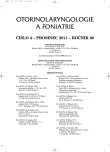Transconjunctival Approach to Blow-out Fractures of Orbit in Children
Authors:
K. Bartoňková; I. Šlapák
Authors‘ workplace:
Dětská ORL klinika LF MU a FN Brno
Published in:
Otorinolaryngol Foniatr, 60, 2011, No. 4, pp. 218-222.
Category:
Original Article
Overview
Introduction:
Blow-out fracture or hydraulic orbit fracture is a specific injury of the orbit. The blow-out fracture most often originates due to a blunt blow on the area of ocular bulb, often at traffic accidents, sports or blow to one’s head.
Materials and methods:
In the years 1994 – 2010, 27 patients with the blow-out orbit fracture diagnosis have been treated at the Child ORL Clinic, Medical Faculty (KDORL LF MU), Masaryk University and Faculty Hospital in Brno. The mean age of the patients was 9.5 years in the range of 5 to 18 years. All patients were examined by CT of the orbit or by NMR. The left side was affected in 19 patients, the right side in eight.
Results:
the surgery was performed in 21 patients. In 6 of them, where diplopia was not present or herniation of the orbit content into maxillary sinus was not proved, the authors used conservative treatment under careful observation. Surgical reposition of the simple blow-out fracture was performed by transconjunctival approach. In case of necessity a specially adapted plate of Zenoderm or Goretex was applied within the whole range of the defect. In two patients a revision surgery was necessary for persisting diplopia.
Conclusion:
The most favorable approach to reposition of hydraulic fracture is apparently the transconjunctival approach from the standpoint of view, procedure simplicity as well as the cosmetic outcome.
Key words:
blow-out orbital fractures, child patients, diplopia, transconjunctival approach.
Sources
1. Bansagi, Z. C., Meyer, D. R.: Internal orbital fractures in the pediatric age group: characterization and management. Ophthalmology, 107, 2000, 5, s. 829-836.
2. Eppley, B. L.: Use of a resorbable fixation technique for maxillary fractures. J. Craniofac. Surg., 1998, 9, s. 317-321.
3. Farwell, D. G, Strong, E. B.: Endoscopic repair of orbital floor fractures. Otolaryngol. Clin. North Am., 40, 2007, 2, s. 319-328.
4. Fukuda, K., Yamada, N., Matsuda, K., Kawai, K., Tomofuji, S., Sakagami, M.: Combination of transconjunctival and endonasal-transantral approach in the repair of blowout fractures involving the orbital floor. Br. J. Plast. Surg., 57, 2004, 1, s. 37-44.
5. Gilliland, G. D., Gilliland, G., Fincher, T., Harrington, J., Gilliland, J. M., Netto, G., Burt, K.: Timing of return to normal activities after orbital floor fracture repair. Plast. Reconstr. Surg., 120, 2007, 1, s. 245-251.
6. Holt, G. R., Holt, J. E.: Incidence of eye injuries in facial fractures: an analysis of 727 cases. Otolaryngol. Head Neck Surg., 91, 1983, s. 276.
7. Iliff, N., Manson, P. N., Katz, J. et al.: Mechanisms of extraocular muscle injury in orbital fractures. Plast. Reconstr. Surg., 103, 1999, s. 787-799.
8. Kakibuchi, M., Fukazawa, K., Fukuda, K., Yamada, N., Matsuda, K,. Kawai, K., Tomofuji, S., Sakagami, M.: Combination of transconjunctival and endonasal-transantral approach in the repair of blowout fractures involving the orbital floor. Br. J. Plast. Surg., 57, 2004, 1, s. 37-44.
9. Lukáš, J.., Rambousek, P.: Příčiny a mechanismus vzniku úrazů obličejového skeletu z ohledu ORL. Otorinolaryng. a Foniat., 49, 2000, 4, s. 233-236.
10. Lukáš J.: K roblematice úrazů vedlejších nosních dutin. Otorinolaryngol., 43, 1994, 4, s. 250-253.
11. Manson, P. N., Grimas, A., Rosenbaum, A. et al.: Studies on enophthalmos, II: the measurement of orbital injuries and their treatment by quantitative computed tomography. Plast. Reconstr. Surg., 72, 1986, s. 203-214.
12. Mwanza, J. C., Ngoy, D. K., Kayembe, D. L: Reconstruction of orbital floor blow-out fractures with silicone implant. Bull. Soc. Belge Ophtalmol., 280, 2001, s. 57-61.
13. Okinawa, Y., Hara, J., Takahashi, M.: Orbital blowout fracture with persistent mobility deficit due to fibrosis of the inferior rectus muscle and perimuscular tissue. Ann. Otol. Rhinol. Laryngál., 108, 1999, 1174-1176.
14. Ondráček ., Janeček D., Autrata .: Záněty očnice v dětském věku. Česká a slovenská oftalmologie, Praha, Česká lékařská společnost J. E.Purkyně, 2002, 6, ISSN 1211-9059..
15. Ozturk, S., Sengezer, M., Isik, S., Turegun, M., Deveci, M., Cil, Y.: Long-term outcomes of ultra-thin porous polyethylene implants used for reconstruction of orbital floor defects. J. Craniofac. Surg., 16, 2005, 6, s. 973-977.
16. Philips, J. H., Rabin, B. A.: Bone healing. In: Yaremchuk, M. J., Gruss, J. S., Manson, P. N. (eds.): Rigid fixation of the craniomaxillofacial skeleton. Boston, Butterworth-Heinemann, 1992.
17. Seno, H., Mizunuma, M., Nishida, M. et al.: 3D-CT stereoscopic imaging in maxillofacial surgery. J. Comput. Assist. Tomogr., 23, 1999, s. 276-279.
18. Skutil, J., Trnka, A.: Případ blow out fraktury s islokací očního bulbu do maxilárního sinu. Otorinolaryng. a Foniat., 50, 2001, 3, s. 194-196.
19. Strong, E. B.: Endoscopic repair of orbital blow-out fractures. Facial. Plast. Surg., 20, 2004, 3, s. 223-230.
20. Waterhouse, N., Lyne, J., Urdang, M. et al. An investigation into the mechanism of orbital blowout fractures. Br. J. Plast. Surg., 52, 1999, 607-612.
21. Winzenberg, S. M., Imola, M. J.: Internal fixation in pediatric maxillofacial fractures. Facial. Plast. Surg., 14, 1998, s. 45-58.
22. Yavuzer, R., Tuncer, S., Basterzi, Y., Isik, I., Sari, A., Latifoglu, O.: Reconstruction of orbital floor fracture using solvent-preserved bone graft. Plast. Reconstr. Surg., 113, 2004, 1, s. 34-44
Labels
Audiology Paediatric ENT ENT (Otorhinolaryngology)Article was published in
Otorhinolaryngology and Phoniatrics

2011 Issue 4
Most read in this issue
- Orbitocellulitis and Its Therapy at the Child Age
- Transconjunctival Approach to Blow-out Fractures of Orbit in Children
- Vocal Fold Augmentation by Autologous Fat – First Experience and Preliminary Results
-
Chirurgická léčba nosní polypózy
Část III.: Symptomatické hodnocení efektu operace
